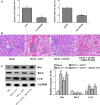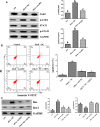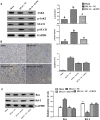LINC00963 targeting miR-128-3p promotes acute kidney injury process by activating JAK2/STAT1 pathway
- PMID: 32270599
- PMCID: PMC7214170
- DOI: 10.1111/jcmm.15211
LINC00963 targeting miR-128-3p promotes acute kidney injury process by activating JAK2/STAT1 pathway
Abstract
The role of long non-coding RNAs (lncRNAs) in kidney diseases has been gradually discovered in recent years. LINC00963, as an lncRNA, was found to be involved in chronic renal failure. However, the role and molecular mechanisms of LINC00963 engaged in acute kidney injury (AKI) were still unclear. In this study, we established rat AKI models by ischaemia and reperfusion (I/R) treatment. Urea and creatinine levels were determined, and histological features of kidney tissues were examined following HE staining. CCK8 assay was chosen to assess the viability of hypoxia-induced HK-2 cells. Dual-luciferase reporter gene assays were performed to verify the target relationship between LINC00963 and microRNA. The mRNA and protein levels were assayed by RT-qPCR and Western blot, respectively. Annexin V-FITC/PI and TUNEL staining were used to evaluate apoptosis. LINC00963 was highly expressed in the cell and rat models, and miR-128-3p was predicted and then verified as a target gene of LINC00963. Knockdown of LINC00963 reduced acute renal injury both in vitro and in vivo. LINC00963 activated the JAK2/STAT1 pathway to aggravate renal I/R injury. LINC00963 could target miR-128-3p to reduce G1 arrest and apoptosis through JAK2/STAT1 pathway to promote the progression of AKI.
Keywords: LINC00963; STAT1 pathway; acute kidney injury; apoptosis; miR-128-3p.
© 2020 Southwest Medical University. Journal of Cellular and Molecular Medicine published by Foundation for Cellular and Molecular Medicine and John Wiley & Sons Ltd.
Conflict of interest statement
The authors declare that they have no competing interests.
Figures






References
-
- Hu C, Sheng Y, Qian Z. Current understanding of inflammatory responses in acute kidney injury. Curr Gene Ther. 2017;17(6):405‐410. - PubMed
-
- Aitken RJ, Baker MA. Causes and consequences of apoptosis in spermatozoa; contributions to infertility and impacts on development. Int J Dev Biol. 2013;57(2‐3‐4): 265–272. - PubMed
-
- Agarwal A, Saleh RA, Bedaiwy MA. Role of reactive oxygen species in the pathophysiology of human reproduction. Fertil Steril. 2003;79(4):829‐843. - PubMed
Publication types
MeSH terms
Substances
LinkOut - more resources
Full Text Sources
Research Materials
Miscellaneous

